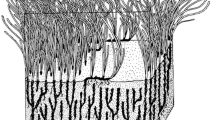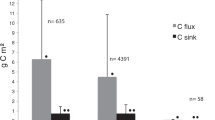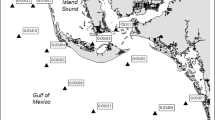Summary
An account is presented of the production of Durvillaea antarctica at Marion Island, including its inter-relationships with higher trophic levels. Biomass was determined for shores with differing degrees of exposure. Data from aerial photography indicated that 48% of the coast is exposed and directly struck by swells, 33% is sheltered or parallel to swell direction, 15% is large boulder or block shore, and 2% is sandy or small-pebble beach. The total fresh mass of D. antarctica, approximately 3,300 t (ww), is situated with varying proportion along each shore type of the island. Calorific content varies with season and with plant organ. Recruitment generally takes place after August on sites having become available after autumn and winter storms. Production in a re-colonizing stand of kelp sporelings is equivalent to 172 × 103 kJ m−2. Low erosion rate and high mortality is a feature of the D. antarctica population. The primary contributors to mortality are grazing by intertidal herbivores and occasional, violent storms. Holdfasts are weakened by boring isopods. Affected plants are torn free and cast onto beaches during storms, where they are attacked by grazing Amphipoda in the spray zone. Beyond this zone, decomposition takes place through bacterial action.
Access this chapter
Tax calculation will be finalised at checkout
Purchases are for personal use only
Preview
Unable to display preview. Download preview PDF.
Similar content being viewed by others
References
Blankley WO, Grindley JR (1985) The intertidal and shallow subtidal food web at Marion Island. In: Siegfried WR, Condy PR, Laws RM (eds) Antarctic nutrient cycles and food webs (Proceedings of the fourth SCAR symposium on Antarctic biology). Springer, Berlin Heidelberg New York
Bunt JS (1955) The importance of bacteria and other microorgan-isms in the sea water at Macquarie Island. Austr J mar Freshwater Res 6: 60–65
Chamberlain YM (1965) Marine algae of Gough Island. Bull Br Mus (Nat Hist) Botany 3: 175–232
Delépine R (1964) Le genera Durvillaea dans les Iles Australe Francais. Com Nat Franc Recherch Antarct 1: 141–147
De Villiers AF (1976) Littoral ecology of Marion and Prince Edward Island (Southern Ocean). S Afr J Antarct Res Suppl 1: 1–40
Dieckmann GS (1980) Aspects of the ecology of Laminaria pallida (Grey) J Ag off the Cape Peninsula. Bot Mar 23: 579–585
Field JA, Griffiths CL, Linley EA, Carter RA, Zoutendyk P (1980) Upwelling in a nearshore marine ecosystem and its biological implications. Estuarine Coastal Mar Sci 2: 133–150
Grindley JR (1978) Marine ecosystems of Marion Island. S Afr J Antarct Res 8: 38–92
Hay CH (1979) A phytogeographical account of the Southern Bull-kelp seaweeds Durvillaea spp Bory 1826 (Durvilliales Petrov 1965) Proc int symp on marine biogeography in evolution in the southern hemisphere 1978, N Z DSIR Information Services 137 (2)
Mann K (1972) Ecological energetics of the seaweed zone in a marine bay on the Atlantic coast of Canada, II Productivity of the sea-weeds. Mar Biol 14: 199–209
McDougal I (1971) Geochronology. In: Marion and Prince Edward Islands. Report on the South African biological and geological expeditions 1965–66.Van Zinderen Bakker EM Sr, Winterbottom JM, Dyer RA (eds). AA Balkema, Cape Town
Moseley HN (1879) Notes by a naturalist on the ‘Challenger’, being an account of various observations made during the voyage of HMS ‘Challenger’ round the world in the years 1872–1876. MacMillan, London
Van Zinderen Bakker EM Sr (1971) In: Van Zinderen Bakker EM Sr, Winterbottom JM, Dyer RA (eds) Marion and Prince Edward Islands. Report on the South African biological and geological expeditions 1965–1966. AA Balkema, Cape Town
Author information
Authors and Affiliations
Editor information
Editors and Affiliations
Rights and permissions
Copyright information
© 1985 Springer-Verlag Berlin Heidelberg
About this paper
Cite this paper
Haxen, P.G., Grindley, J.R. (1985). Durvillaea antarctica Production in Relation to Nutrient Cycling at Marion Island. In: Siegfried, W.R., Condy, P.R., Laws, R.M. (eds) Antarctic Nutrient Cycles and Food Webs. Springer, Berlin, Heidelberg. https://doi.org/10.1007/978-3-642-82275-9_87
Download citation
DOI: https://doi.org/10.1007/978-3-642-82275-9_87
Publisher Name: Springer, Berlin, Heidelberg
Print ISBN: 978-3-642-82277-3
Online ISBN: 978-3-642-82275-9
eBook Packages: Springer Book Archive




